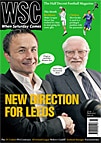 David Beckham’s mission to explain his sport to Americans while making lots of money is going well. For a start, as Mike Woitalla writes, more of them have discovered that Los Angeles has a soccer team
David Beckham’s mission to explain his sport to Americans while making lots of money is going well. For a start, as Mike Woitalla writes, more of them have discovered that Los Angeles has a soccer team
On the second Friday of 2007, nearly every American newspaper reported the deal on its front page, next to news that made the man seem all the more appealing. On the Miami Herald’s page one, he celebrated a goal beneath photos of hooded protesters dressed as Guantánamo prison detainees and of US Secretary of State Condoleezza Rice. In the New York Times he took a shot while, to his right, Rice argued emphatically for a troop increase in Iraq.
In the Los Angeles Times, David Beckham stood in a blazer next to Posh Victoria, who for once, probably because she was juxtaposed to Condi the Warrior Princess, looked halfway friendly. Further down the page was a shot of a displaced little Iraqi girl.
Rupert Murdoch’s New York Post relegated Rice to a small mug-shot at the bottom while bare-chested Beckham dominated the tabloid’s cover, which read Spend it like Beckham: David’s $250m US deal. Major League Soccer, in the middle of its off‑season, was enjoying the biggest jolt of publicity in its 11-year history.
It has had, in the past couple of years, much good news. Expansion teams, new investors, a television deal that will finally pay rights fees to the league and the construction of more soccer-specific stadiums. Progress indeed, but not much that would excite anyone who wasn’t already dedicated to MLS. And that has been a problem. MLS ownership has been fine at making prudent business decisions. It would be hard to think of another league in the world whose owners are as financially shrewd and level-headed as MLS’s. (Granted, the bar isn’t set very high.) Their building of stadiums and their launch of youth programmes demonstrate a long-term commitment. But their frugality on the transfer market has been frustrating.
The lack of high-quality players has kept away those who prefer watching the Mexican league, which gets higher TV ratings than MLS games, or the English Premiership. Upon its launch, MLS signed a number of Latin American heroes, such as Marco Etcheverry, Jorge Campos and Carlos Valderrama, who drew fans and entertained. But its most-hyped signing of the past few years has been 14-year-old Freddy Adu.
MLS rules capped the payroll of a club’s entire roster at about $2 million (worth barely £1m at current exchange rates). The average annual player salary in the league is $100,000. It all made sense on the bottom line, but it started to get boring. Then last year MLS instituted the “designated player rule”, which allows each club to sign one player whom they can pay as much as they want. It was initially referred to as the “Beckham rule” and it opened the door to the new year’s excitement.
Beckham will receive a guaranteed salary of $50m over five years, paid for mainly by Galaxy owner and top league patron Phil Anschutz, whose net worth is $7.8 billion. The rest of the “$250m” comes from Beckham’s share of jersey and ticket sales, and from his existing sponsorship deals. (As Real Madrid did after they bought Beckham, the Galaxy will tour Asia, where his jerseys sell so well.)
Like all big news stories, the deal made its way into the monologues of late-night talk-show hosts. Alluding to the fact that Beckham’s fame here stems much from the hit movie that grossed $32m in the cinemas, Comedy Central’s Stephen Colbert suggested the sequel, Bend It Like Beckham 2: Bend It Exactly Like Beckham Because You Are Him. But Craig Ferguson’s quip on CBS’s Late Late Show – “He is going to play for the Galaxy soccer team. Which is huge news! I think I speak for everyone when I say, ‘LA has a soccer team?’” – hit a chord.
Aside from having the word in its name, MLS hasn’t reached “major” league status. Several teams have solid support – the Galaxy average crowds of around 20,000 – but the league-wide attendance average hasn’t broken the 16,000 mark since its inaugural season. The problem isn’t a lack of soccer fans in the USA – which was the case when the North American Soccer League brought Pelé over in 1975. Pelé was the NASL’s lead missionary as it planted the sport’s seeds around the nation, before it folded seven seasons after Pelé left. Most NASL club owners were enticed by the New York Cosmos’ glamour, spent foolishly and cared not enough about soccer to commit long-term.
MLS has realized it’s time to start going for some glitz. Beckham’s on-field appeal may be limited to decent crosses and scoring the odd free-kick, but MLS could not have found another player who would be so heartily embraced in the USA. His grammar and intelligence may be mocked in his homeland, but Americans find all British accents smart and charming.
When Beckham appeared via satellite on the popular Good Morning America show, hosts Diane Sawyer and Robin Roberts could hardly contain themselves. “If you’re not already a soccer fan you gotta be a David Beckham fan,” said Sawyer, before she and Roberts giggled their way through the interview in which Beckham’s pleasant countenance made even his “it’s not about the money, it’s about hopefully making a difference” seem sincere.
From WSC 241 March 2007. What was happening this month